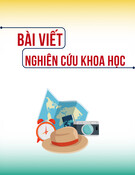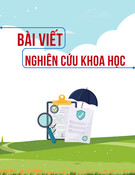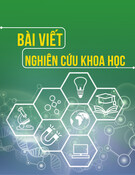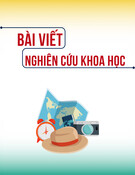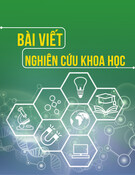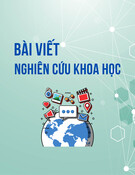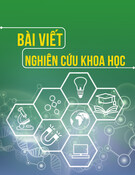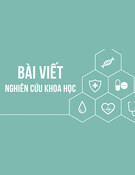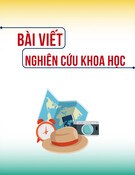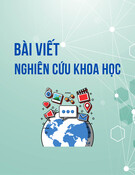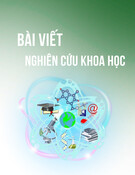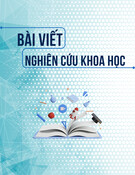
VĂN HÓA https://jst-haui.vn Tạp chí Khoa học và Công nghệ Trường Đại học Công nghiệp Hà Nội Tập 60 - Số 10 (10/2024)
52
NGÔN NG
Ữ
P
-
ISSN 1859
-
3585
E
-
ISSN 2615
-
961
9
STUDENTS’ PERCEPTIONS OF THE EXTENSIVE READING ACTIVITY AMONG FIRST-YEAR ENGLISH MAJOR STUDENTS AT SCHOOL OF LANGUAGES AND TOURISM
NHẬN THỨC CỦA SINH VIÊN NĂM NHẤT CHUYÊN NGÀNH TIẾNG ANH VỀ HOẠT ĐỘNG ĐỌC MỞ RỘNG TẠI TRƯỜNG NGOẠI NGỮ - DU LỊCH Luong Thuy Nguyet1,*, Nguyen Truong Thanh2 DOI: http://doi.org/10.57001/huih5804.2024.324 ABBREVIATIONS L2 Second language ER Extensive reading ESL English as a second language EFL English as a foreign language 1. INTRODUCTION As the most commonly spoken foreign language in Vietnam, English plays a key role in education at all levels. Extensive reading (ER) is considered effective in language teaching and learning [5, 8, 14, 17, 22] and has been integrated into ESL/EFL teaching approaches in various countries. At the School of Languages and Tourism, ER activities are integrated into the first-year English reading curriculum. However, there is limited understanding of students' perceptions of this practice. This study investigates first-year English major students' attitudes toward ER activities, addressing the question: “What are first-year English majors’ perceptions of extensive reading activities?” Despite considerable research interest in ER, students’ perspectives on this ABSTRACT The importance of reading in second or foreign language acquisition is well-
established, and
extensive reading has been widely recognized for its benefits. However, little is known about students’
perceptions of the activity, particularly among first-year
English major students at the School of
Languages and Tourism, Hanoi University of Industry. This 10-
week research study, involving 52
students,
aimed to analyze their perceptions of the extensive reading activity. Through the use of
questionnaires and an
analysis of students’ weekly reading logs, the study revealed that students
perceived improvement in vocabulary, increased engagement, and a more positive attitude toward
reading. The findings offer valuable insights for educators and researchers intereste
d in exploring
extensive reading further. Keywords: Extensive reading, reading comprehension, reading log, students’ perception. TÓM TẮT Tầm quan trọng của việc đọc trong quá trình học ngôn ngữ thứ hai hoặc ngoại ngữ đã được khẳ
ng
định và lợi ích của hoạt động đọc mở rộng được công nhận rộng rãi. Tuy nhiên, nhận thức củ
a sinh viên
đối với hoạt động này, đặc biệt là đối với sinh viên năm nhất chuyên ngành tiếng Anh tại Trường Ngoạ
i
ngữ - Du lịch, Trường Đại học Công nghiệp Hà Nội vẫn chưa được tìm hiểu rộng rãi. Nghiên cứu kéo dà
i
10 tuần với 52 sinh viên nhằm phân tích nhận thức của sinh viên về hoạt động đọc mở rộ
ng. Thông qua
việc sử dụng bảng câu hỏi và phân tích nhật ký đọc hàng tuần của sinh viên, nghiên cứu đã cho thấ
y
sinh viên đã nhận thấy sự cải thiện vốn từ vựng, có thái độ và sự tham gia vào hoạt động tích cự
c hơn.
Những phát hiện này mang lại những hiểu biết quý giá cho các nhà giáo dục và nhà nghiên cứ
u quan
tâm đến việc khám phá thêm về hoạt động đọc mở rộng. Từ khóa: Đọc mở rộng, đọc hiểu, nhật ký đọc, nhận thức của sinh viên. 1School of Languages and Tourism, Hanoi Univeristy of Industry, Vietnam 2Forensic Science Institute, Ministry of Public Security, Vietnam *Email: nguyetlt@haiu.edu.vn Received: 06/9/2024 Revised: 21/10/2024 Accepted: 28/10/2024





